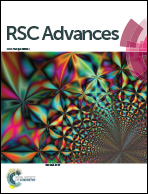Improving performance of MoS2-based electrochemical sensors by decorating noble metallic nanoparticles on the surface of MoS2 nanosheet†
Abstract
Recently, the use of a molybdenum disulfide (MoS2) nanosheet as a sensing platform has attracted more and more scientists' attention due to its graphene-like structure and excellent physical/chemical properties. Herein, the performances of MoS2-based electrochemical sensors were improved by decorating noble metallic nanoparticles on the surface of the MoS2 nanosheet. Taking catechol (CC) as an analyte, it could be found that the MoS2 nanosheet and its derivatives have excellent electrocatalytic abilities toward CC. More interestingly, the gold nanoparticles-decorated MoS2 nanosheet (Au–MoS2), platinum nanoparticles-decorated MoS2 nanosheet (Pt–MoS2) and gold–platinum core–shell nanoparticles-decorated MoS2 nanosheet (Au@Pt–MoS2) modified electrodes exhibited better detection performances than the pure MoS2 nanosheet and metallic nanoparticles modified electrodes due to their synergistic effect. As expected, the Au@Pt–MoS2 nanocomposites modified electrode exhibited the linear range of 2–1000 μM and the detection limit of 0.44 μM for CC detection, which was better than all MoS2-based nanomaterials. All the MoS2-based electrochemical sensing platforms were employed to determine CC both in buffer and in real samples with satisfactory results, suggesting MoS2-based nanomaterials maybe the potential candidates for constructing electrochemical sensors for chemical and biological molecules detection.


 Please wait while we load your content...
Please wait while we load your content...